This article was medically reviewed by Erik Kramer, DO, MPH. Dr. Erik Kramer is a Board-Certified Primary Care Physician at the University of Colorado. With over 15 years of experience, his clinical interests include obesity and weight management, diabetes care, and preventive care, as well as embracing a holistic approach to primary care. He received his Doctorate in Osteopathic Medicine (D.O.) from the Touro University Nevada College of Osteopathic Medicine and completed his residency at Central Maine Medical Center. Dr. Kramer is a Diplomate of the American Board of Obesity Medicine.
There are 16 references cited in this article, which can be found at the bottom of the page.
This article has been viewed 10,846 times.
Arterial bleeding happens when an injury or accident has severed a main artery. It’s rare you’ll ever encounter this type of bleeding, but you’ll notice the difference because the blood will come out in pulsing spurts and will look bright red.[1] Whether you have a first aid kit available or not, you can help someone by trying to stop or slow the bleeding as much as possible until an ambulance arrives. In case the person goes into shock and stops breathing, be prepared to give them CPR.
Steps
Responding Quickly
-
1Call an ambulance or instruct someone else to right away. When it comes to deep puncture wounds, calling for professional medical care right away is the best first step to helping the injured person. Arterial bleeding is very rare, but can be quite serious depending on the depth and location of the wound. If there's someone else nearby, tell them to call while you assess the person's condition and begin to take steps to stop the bleeding.[2]
- If you’re the one who’s injured, call an ambulance on your phone or get the attention of a bystander as soon as you can.
- If you're in a place that has a first aid kid nearby, tell a bystander to get it and bring it to you as soon as possible.
-
2Sit down or make sure the injured person is sitting down. Losing blood can make you or the injured person feel lightheaded. It’s not likely to happen, but it’s possible that the loss of blood could cause you or the injured person to lose consciousness. Make sure you or they are sitting down on a soft surface where there's no risk of further injury from falling over.[3]
- If you're outside, a grassy area is the perfect spot.
- If you suspect you may have broken something, don’t try to move. Lie down still and focus on breathing through any pain you may feel while you wait for help to arrive.
- If you suspect the injured person may have broken something or if you can't move them, instruct them to lie down wherever they are.
- Someone who's about to pass out may show the following signs: dizziness, paleness, confusion, trouble hearing, blurred vision, sweating, nausea, or a slow pulse.
Advertisement -
3Wash your hands well or put on gloves if possible. Make sure your hands are clean before you tend to the open wound if you can. If you're near a bathroom, quickly go wash your hands. If not, make sure you don't touch the open wound with your unwashed hands because any bacteria that get into it could lead to an infection.[4]
- Most first aid kits come with gloves or some sort of hand sanitizer. If that's the case, use one of those options.
- If you’re injured and can’t move, don’t put your bare hand directly over the wound. Use your shirt, a clean rag, or any cloth-like material you can find that isn’t soiled.
- If you wear rings or other jewelry on or near your hands, take those off before you deal with the wound.
- If you can, put on a mask or face shield as well. This will help prevent blood from splashing into your eyes, nose, or mouth, which could put you at risk of infection.
Stopping the Bleeding
-
1Apply deep pressure to the wound with gauze or clean cloth. Lay a clean strip of gauze, tissue paper, or clean cloth over the bleeding wound. Hold onto it tightly and press down firmly, but not so much that you’re hurting the injured person. Gauze is the best option, but the cleanest cloth available (like a shirt or clean rag) will also work in an emergency or non-emergency situation.[5]
- If there's a piece of glass or another object in the wound, don't try to remove it—the medics can do that once they arrive. Press down on the wound around the object, not directly on top of it.
- If the injured person is conscious and you’re helping them, they can assist by holding the gauze or cloth in place and applying pressure while you’re collecting more gauze.
-
2Apply another sheet of gauze on top of the first one, if necessary. In most cases, a single sheet of gauze will do, but you may need another one if you’re dealing with a deeper cut. In the rare case that blood seeps through the first layer of gauze or cloth, place another sheet on top of the first one. Don't remove the first layer because it could cause the blood clot to rip off or break.[6]
- The clot is important to stop the bleeding as soon as possible.
- Clotting typically takes anywhere from 10 to 20 minutes. Resist the urge to lift the gauze and see if the wound has stopped bleeding.[7]
- If the wound is very deep or cavernous and the gauze is soaked within a few seconds of putting it on, wad up a clean sheet of gauze and pack it into the wound to slow the bleeding. Then apply more layers of gauze over the top.[8]
-
3Apply a pressure bandage to hold the gauze in place. If the bleeding is somewhat controlled (that is, if it’s not bleeding through the gauze), wrap the wound and gauze with sterile bandage wrapping. Use one hand to hold one end of the wrapping over the wound at the distal end (the part farthest away from their heart). Use your other hand to circle the bandage around their limb.[9]
- Tuck the end of the bandage under one of the tight strips to secure it.
- Make sure the wrapping is pulled taut but not so tight that the person's fingers or toes turn blue. Pinch the person’s toe or fingertip and check—their nail should briefly turn white and then red again within a second or 2. If it stays white, re-wrap the bandage a little looser.
- Most first aid kits contain sterile bandage wraps. If you don't have bandage wraps available, use a strip of cloth such as a shoelace, a necktie, or a torn strip of bedsheet. Choose a cloth that’s as clean as possible.
-
4Twist the gauze over the wound to add more pressure if necessary. If you’re in a rural area and suspect it may take over 15 minutes for the medics to arrive, adding more pressure to the wound is the best thing you can do. Once you loop the wrapping around the person’s extremity a few times, twist it once right over where the cut is to add more pressure to the wound.[10]
- If the injury and subsequent bleeding are life-threatening and help won’t arrive for over 20 minutes, you can improvise a tourniquet with a belt, necktie, bandana, or scarf. Make sure the material is at least 1.5 inches (3.8 cm) thick. Otherwise, it may not stop the bleeding and could cause nerve damage.[11]
-
5Apply pressure to a main artery between the wound and heart if necessary. If the wound is still bleeding through the bandaging, it may help to apply pressure to a main artery located between the wound and the person’s heart. Use 2 or 3 fingers to push the blood vessel against the person’s bone. There are 4 main pressure points that can stop bleeding in particular areas:[12]
- Femoral artery: located on the front of their upper thigh just below the level of their groin. Apply pressure to this point for deep thigh wounds.
- Popliteal artery: located at the back of their knee. Use this point for wounds of the lower leg.
- Brachial artery: located just above their elbow near the front of their lower bicep. This is a good spot if the injury is slightly above or anywhere below their elbow.
- The radial artery is located on the person's inner wrist about 2 or 3 fingers up from where their palm meets their wrist. Apply pressure at this point if the wound is on their hand.
-
6Put a tourniquet on an injured limb if other methods don’t work. If the injured person is bleeding from an arm or leg and you aren’t able to stop the bleeding with pressure alone, apply a tourniquet. Place the tourniquet at least 2–3 inches (5.1–7.6 cm) above the wound, between the wound and the heart. Clip the tourniquet in place and tighten it as much as you can by pulling on the strap, then twist the windlass rod to tighten it even more, until the bleeding stops. Use the windlass clip to secure the rod in place.[13]
- If you don’t have a tourniquet, make your own with a belt or a strip of cloth, such as a strip torn out of a bedsheet. If you’re using cloth, knot a stick or a pen into the cloth and twist that to tighten the tourniquet.
- If you have to wait a long time for help, you’ll need to loosen the tourniquet every 45 minutes to prevent tissue damage. Keep note of the time so that you’ll know how often to do it. Luckily, in most situations, you won’t have to wait that long for help to arrive.
- Never apply a tourniquet to a wound that’s not on a limb, and don’t apply a tourniquet directly to a joint (such as an elbow or knee).
Waiting for Help to Arrive
-
1Elevate the wounded limb above their heart if you can. If the injured person is aware and able to move, elevate their arm or leg above their heart to help slow the bleeding. If you can't move them because you suspect they may have a broken limb, the best thing you can do is focus on applying direct pressure until the medics arrive.[14]
- If you’re injured and it hurts to move, stay where you are until the medics arrive.
-
2Stay calm or keep the injured person as calm as possible. The sight of blood may bring on a state of shock in you or the injured person. If you're injured, focus on taking long, deep breaths and try not to let panicked thoughts overwhelm you. If you're tending to someone else, reassure them that they'll be okay and that help is on the way. Symptoms of shock include:[15]
- Cold or clammy skin
- A weak, rapid pulse
- Faintness or dizziness
- Nausea.
-
3Check the injured person’s condition or let someone know if you feel faint. Examine the person’s face to see if they’re turning pale or bluish, which can happen in rare cases where there’s lots of blood loss. If you’re the one who is injured, let the person caring for you know if you feel faint or dizzy so they can prepare to support you if you were to pass out.[16]
- You can test their mental state by asking them easy questions like, “What day is it?” or “Do you remember what you were doing right before the accident?”
- If you’re injured and feeling faint after a cut, it’s not always a life-threatening situation. In most cases, it’s just your nervous system going into overdrive due to the trauma of the injury.
-
4Keep the injured person warm with a blanket or jacket. In rare, severe cases, losing blood can cause you or the injured person to feel cold and start shivering. Cold sensations and shivering can be scary to the person who is bleeding, so try to keep them as warm as possible to prevent them from feeling anxious and going into shock.[17]
- Be extremely careful putting the blanket or jacket over them, especially if there is a blunt object stuck inside the wound.
- Be sure to keep their hands and feet warm because those are usually the first places to feel extra cold during blood loss.
-
5Lie still and breathe deeply or instruct the injured person to do so. Whether it’s you or another person who’s injured, staying still will prevent further injury or excess blood flowing to the site of the wound. Every minute may feel like an hour in an emergency situation, so try your best to stay calm and keep the injured person calm. Breathing is key![18]
- If the wound is on one of your or the other person’s legs, keep your or their legs elevated if you can.
- Inhaling for 7 seconds, holding it for 4 seconds, and exhaling for 7 seconds is a good breathing practice to ease anxiety and prevent shock.
Warnings
- Someone who is bleeding from an artery always requires professional medical help, so call an ambulance as soon as possible (even if the injured person suggests it’s not that bad).[22]⧼thumbs_response⧽
References
- ↑ https://sjrhem.ca/rcp-arterial-bleeding/
- ↑ https://www.health.harvard.edu/staying-healthy/emergencies-and-first-aid-direct-pressure-to-stop-bleeding
- ↑ https://www.nhs.uk/conditions/fainting/
- ↑ https://www.uofmhealth.org/health-library/tw9012
- ↑ https://www.mayoclinic.org/first-aid/first-aid-severe-bleeding/basics/art-20056661
- ↑ https://www.mayoclinic.org/first-aid/first-aid-severe-bleeding/basics/art-20056661
- ↑ https://www.urmc.rochester.edu/encyclopedia/content.aspx?contenttypeid=1&contentid=2978
- ↑ https://www.bleedingcontrol.org/-/media/bleedingcontrol/files/stop-the-bleed-booklet.ashx
- ↑ https://www.health.harvard.edu/staying-healthy/emergencies-and-first-aid-direct-pressure-to-stop-bleeding
- ↑ https://youtu.be/biwOVrPW7TQ?t=226
- ↑ https://youtu.be/biwOVrPW7TQ?t=170
- ↑ https://www.tdi.texas.gov/pubs/videoresource/t5firstaidbleed.pdf
- ↑ https://www.dhs.gov/sites/default/files/publications/STB_Applying_Tourniquet_08-06-2018_0.pdf
- ↑ https://www.tdi.texas.gov/pubs/videoresource/t5firstaidbleed.pdf
- ↑ https://healthywa.wa.gov.au/Articles/F_I/First-aid-for-shock
- ↑ https://www.health.ny.gov/professionals/ems/pdf/srgpsbleeding.pdf
- ↑ https://www.health.ny.gov/professionals/ems/pdf/srgpsbleeding.pdf
- ↑ https://www.health.harvard.edu/staying-healthy/emergencies-and-first-aid-direct-pressure-to-stop-bleeding
- ↑ https://blogs.findlaw.com/law_and_life/2013/05/9-tips-on-making-an-effective-911-call.html
- ↑ https://blogs.findlaw.com/law_and_life/2013/05/9-tips-on-making-an-effective-911-call.html
- ↑ https://www.wta.org/go-outside/trail-smarts/like-your-life-depends-on-it-building-your-first-aid-kit
- ↑ https://www.health.harvard.edu/staying-healthy/emergencies-and-first-aid-direct-pressure-to-stop-bleeding
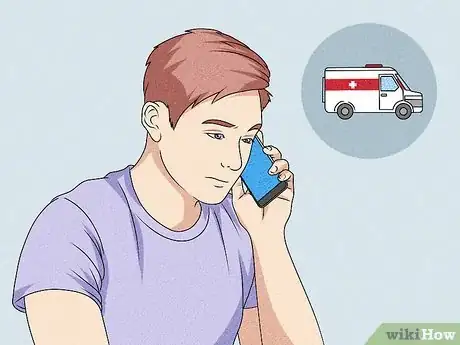

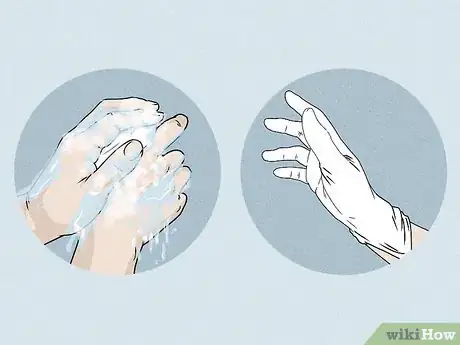
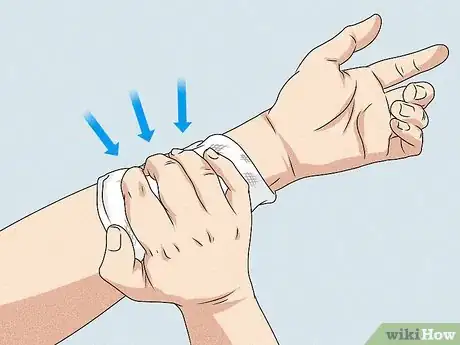

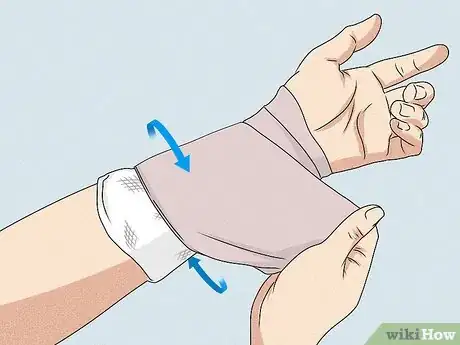
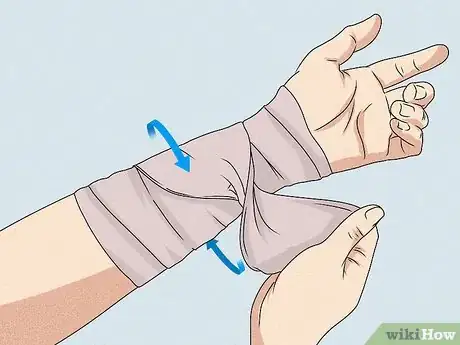
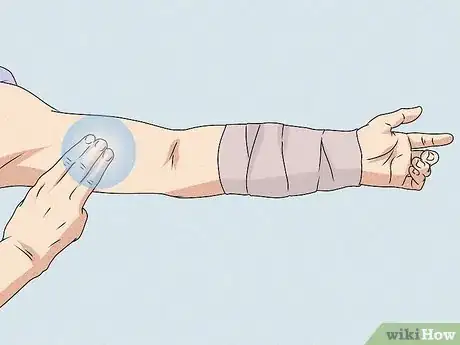
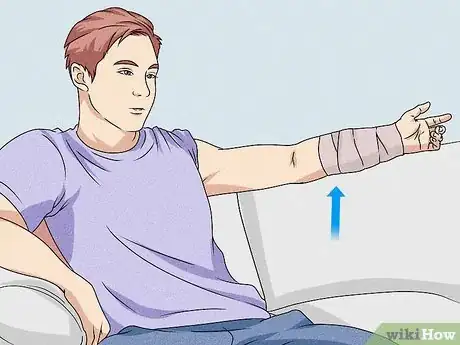
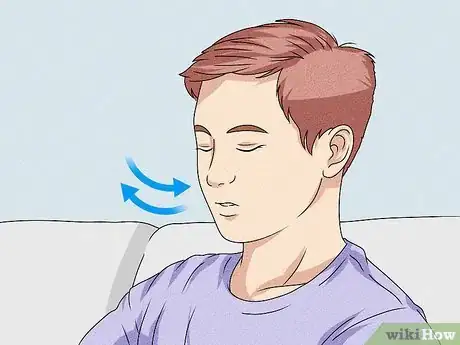


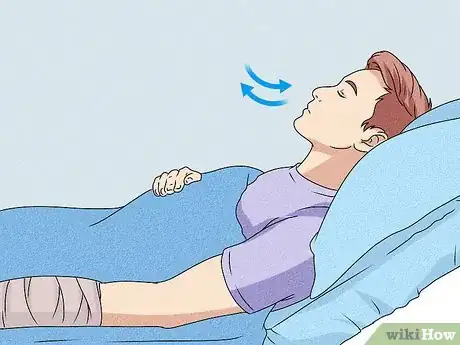
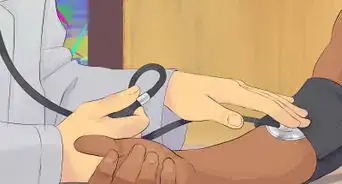
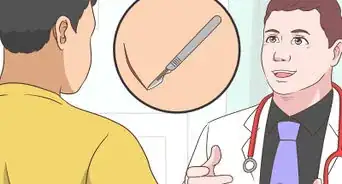
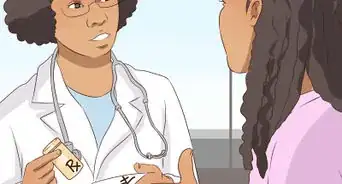








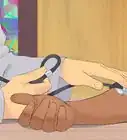
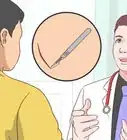
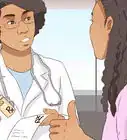




































Medical Disclaimer
The content of this article is not intended to be a substitute for professional medical advice, examination, diagnosis, or treatment. You should always contact your doctor or other qualified healthcare professional before starting, changing, or stopping any kind of health treatment.
Read More...